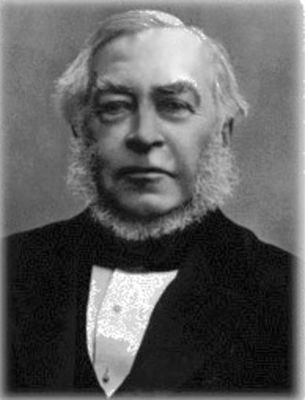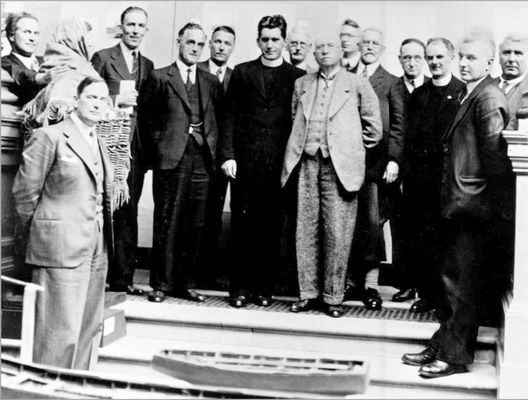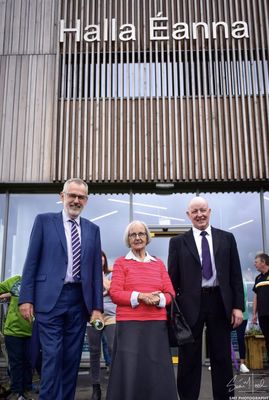PADDY O’Kane was the first Catholic to buy a house on Hightown Road, Glengormley. Originally from Ballinderry on the Tyrone/Derry border, his family had moved to the Antrim Road Belfast some years earlier and when Paddy married he took a liking to Glengormley village, settling there in 1962.
Paddy often told me how small the community was then. There was just one Mass in St Mary’s on the Hill with an attendance of about thirty. The M2 motorway was under construction and there were no houses other than a few farmhouses beyond the M2 bridge on Hightown Road. “The only people who passed up by our door were courting couples,” he recalled. “It was known as the road to nowhere.” While some locals ignored him, others originally greeted Paddy as Mr Kane but he quickly reminded them that there was an O in his name. Paddy watched Glengormley grow and become more and more integrated.
With the rise in numbers in the Glengormley district new schools were needed with the great influx of young families.
A new Catholic parish was created in Glengormley with Father Shaun McClafferty as first PP. No man was better suited to the task. He identified and purchased land for future development. A run-down large property known as Elmfield House on Antrim Road became parish headquarters with a Nissen hut serving as an oratory and the construction of a new primary school quickly set in motion. This development acted as a magnet for incoming Catholic families and Elmfield estate house prices began to rise.
The onset of civil unrest might have bypassed Glengormley. Given that the vast majority of the homes were being purchased with 25-year mortgages the district might well have remained unscathed. However, events in Rathcoole and other large housing estates had their effect. In the 1970s the Catholic population of Rathcoole came under pressure.
Eventually the whole Catholic population, estimated as a third of the total, was either physically evicted or intimidated into moving. It was the biggest movement of population in Europe since World War 2. Many of the families moved to West Belfast to new estates such as Twinbrook. Others were more fortunate in having savings and a good number of them bought houses in Glengormley, many in Elmfield, and as you can guess they were determined never to be intimidated again.
Some of the families evicted from Rathcoole refused to move to “the outskirts of Lisburn” as one man put it to me. They feared that the same thing might happen again. One man I knew split his large family up with children staying with different relatives while he pressured the Housing Executive for accommodation nearby. He ran into every possible obstacle. The RUC had no record of any attacks on his Rathcoole home though he had contacted them twelve times. Eventually a former neighbour gave evidence that he had sat in their house for three nights armed with a shotgun after windows had been broken.
The response of the RUC was to attempt to take away Paddy’s gun licence. They failed. Eventually the Housing Executive bought a house in Elmfield and let it to the homeless family. I became aware of this scheme one day when I went to the shop in Elmfield to buy a newspaper. As I was walking along a voice rang out: “Hi, stranger, are you not talking to anyone?”
It was the voice of a man I had been speaking to in the Bellevue Arms a few nights previously. We stood chatting at his garden gate, joined by his wife, when a clergyman came out from the house next door. He must have assumed that I was either of his or a similar persuasion for he began explaining his mission to all three of us.
“You two are buying your own home here,” he said, ”and it gives us independence and security. People own their own houses and have to look after them. You have to pay your rates so you have to budget. People who come here have to sink or swim. If they can't afford to live here they move out. The Housing Executive have told me they can't build any houses in Glengormley for they have no land but they're buying houses here in Elmfield and letting them out. Some people here are struggling to pay their mortgages and then find” (at this stage he waved his arms and pointed to a house opposite) “that they are living next door to someone who is paying a small rent. You'll be glad to know I have got them to stop.” And with that he moved on to knock the door of the next house. The couple were embarrassed with Mrs Thompson saying: “Is it any wonder I don't go to listen to him on Sundays? He does go on a bit.”
I discovered later that the Housing Executive had bought a number of houses in Elmfield to house families evicted from Rathcoole and had stopped the practice, not because of protest by people like that clergyman, but because prices had risen sharply.
I later discovered that the house identified by the clergyman had been allocated to a good friend of mine. Had it not been for the clergyman’s intervention no neighbour would have been aware that the house was rented. That family would have been seen as the best neighbours anyone could have and when the youngest daughter of the house took up a career in a bank she bought the house!
Since the boom around 1980, Glengormley has changed. Most of the shops mentioned in the first article are gone. The building of a Tesco superstore at Northcott and the development of the Abbey Centre have meant that the demand for commercial premises in Glengormley is practically non-existent. The recent development of Eurostar on the Antrim Road has killed off any of the smaller shops still open. The most common sign in Glengormley now is TO LET or FOR SALE. Fast food takeaways vie with estate agents for prominence. Car parking is no longer a problem. Many comments have been made about how town centres have been silenced by Covid-19. Glengormley didn't have to wait for the pandemic.
Despite having the worst credentials for being included in the motto for Newtownabbey, ‘Seven shall rise as one’, Glengormley has become more recognisable than any of the other six. The notion of Newtownabbey as being a recognisable town has long ceased to exist. The new council, Antrim and Newtownabbey, is very much an administrative entity.
Historically the district has had its share of community tensions but with greater integration it is hoped that we can improve with time. The absence of the Orange arch in the centre of Glengormley this year because of Covid-19 was welcomed by a great number of people. This was the first year we haven't had the contentious ‘Opening of the Arch’ parade. On July 12th the local Orange band from Queen’s Park made their way to the War Memorial in Lilian Bland Park before visiting localities where they were welcomed. No-one was offended. They laid a blueprint for the future.
Steps should now be taken to make sure the arch never reappears in the centre of Glengormley and that the main thoroughfare can be free of flags.
Glengormley has become a secure residential entity. Many who live there work in Belfast and transport services are adequate. There are a number of housing developments ongoing. Gone are the days of the standard semi-detached villa. Bigger housing units are being developed and many of the children of those who migrated here in the 60s, 70s and 80s are happy to settle here.
Paddy O’Kane’s ‘Road to nowhere’ – the Hightown Road – now boasts several housing estates of varying size and design contrasting with the monopoly of semi-detached villas elsewhere and is a model of social integration.
The presence of a cinema and bowling alley, the nearby leisure centre, golf, rugby, soccer and GAA facilities all help to make Glengormley a good place to live – and we are only 15 minutes away from the centre of Belfast.
We even get snow when few other places have it.







